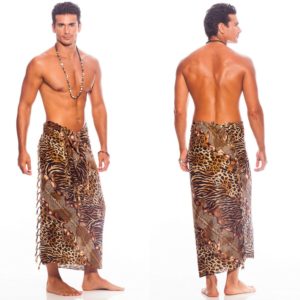Being a traditional outfit in hot tropical countries, the sarong has attracted fashionistas all over the world. Today it is not just traditional men's or women's clothing, but also a beach fashion item that can be tied in different ways, giving the image individuality.
What is a sarong?
 The sarong is a long, wide piece of fabric worn by both men and women in Oceania and Southeast Asia. Men wrap the fabric around their waist and it loosely covers the lower part of the body down to the ankles. Women tie a cloth under their breasts for the same purpose. The sarong is most common in Myanmar, Polynesia, Indonesia, India, Bangladesh and Cambodia.
The sarong is a long, wide piece of fabric worn by both men and women in Oceania and Southeast Asia. Men wrap the fabric around their waist and it loosely covers the lower part of the body down to the ankles. Women tie a cloth under their breasts for the same purpose. The sarong is most common in Myanmar, Polynesia, Indonesia, India, Bangladesh and Cambodia.
It is noteworthy that it is not customary to wear underwear under such clothes, so it is the only clothing of the locals, which they try to tie so that it does not slip off. From this movement, the gait of local residents becomes smooth and soft.
Important! During work, the fabric is often tied in knots at the bottom or tucked into the belt. You can also do this in cool weather.
 Women use sarongs as beachwear. On the beach you can often find ladies wearing a light flowing scarf tied around the waist or above the chest. Most often, pareo, as the beach version of this clothing is called, is made from:
Women use sarongs as beachwear. On the beach you can often find ladies wearing a light flowing scarf tied around the waist or above the chest. Most often, pareo, as the beach version of this clothing is called, is made from:
- Cotton;
- Viscose;
- Silk and other materials.
Pareos are used to visit the beach, pool or sauna. Each time you can tie it in a new, original way, creating a unique outfit.
How should you wear a sarong?
 It's no secret that a pareo successfully emphasizes absolutely any type of figure. It can be worn by slender petite girls and ladies with curvy figures. Stylists still recommend choosing the type of fabric tying in advance in order to emphasize the advantages of the silhouette and hide existing shortcomings:
It's no secret that a pareo successfully emphasizes absolutely any type of figure. It can be worn by slender petite girls and ladies with curvy figures. Stylists still recommend choosing the type of fabric tying in advance in order to emphasize the advantages of the silhouette and hide existing shortcomings:
- short girls with large breasts are recommended to tie the fabric at the hips and leave the fabric flowing freely down;
- For women with small breasts, it is best to tie the fabric directly on the chest with a large bow, creating the necessary volume;
- a short waist requires a visual lengthening of the silhouette, this effect can be achieved by securing the sarong above the chest and on the side; it is better to choose a pareo with a large longitudinal print;
- for women with curvy hips and a large belly, pareos with a vertical pattern are suitable; they will visually elongate the silhouette and make it slimmer; it is better to tie the fabric at the waist at an angle;
- For girls with short legs, sarongs in the form of a miniskirt or long pareos with a vertical pattern and without a border are ideal.
In stores you can find a huge number of sarong options that will suit every woman’s taste. Various fabrics, prints and textures make it possible to create unique images for all occasions.
Fashionable options for beautifully tying a sarong
 There are a huge number of ways to tie a sarong correctly. The most common is tying like a miniskirt. To do this, the fabric is folded in half and wrapped around the waist, tying the corners with a knot.
There are a huge number of ways to tie a sarong correctly. The most common is tying like a miniskirt. To do this, the fabric is folded in half and wrapped around the waist, tying the corners with a knot.
You can wear a pareo in the form of a toga. The ends of the fabric are secured to the shoulder using a knot or inserted into a specially selected buckle. Some ladies prefer to form a pareo into a dress by tying the corners around the neck. Some girls like to just tie the fabric in a big knot across their chest. This helps to visually enlarge the shape and lengthen the legs.
You can also make a long skirt by tying a sarong around your waist. A big bow at the front or neatly tucked ends at the waist give a completely different look. A girl should experiment, choosing the option that best suits her image.


 0
0





